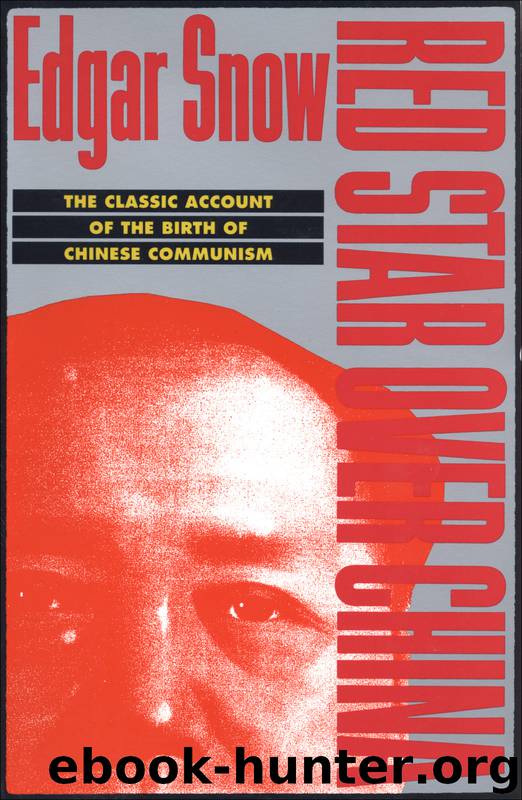Red Star over China by Edgar Snow

Author:Edgar Snow
Language: eng
Format: epub
Publisher: Grove/Atlantic, Inc.
Published: 1938-11-22T16:00:00+00:00
3
Four Great Horses
One might say that Chinghai, Ninghsia, and northern Kansu were the prototype of that fantasia of Swift’s, the land of the Houyhnhnms, for they were ruled as the satrapy of Four Great Horses whose fame was widespread in China. Over the areas mentioned power was divided (before the Reds began edging the Houyhnhnms out of considerable portions of their domain) by a family of Mohammedan generals named Ma—the Messrs. Ma Hung-kuei, Ma Hung-ping, Ma Pu-fang, and Ma Pu-ch’ing. And this particular Ma means horse.*
Ma Hung-kuei was governor of Ninghsia, and his cousin, Ma Hung-ping, former governor of the same province, was now ruler of a shifting fiefdom in northern Kansu. They were distantly related to Ma Pu-fang, many-wived son of the famous Mohammedan leader Ma Keh-chin. Ma Pu-fang inherited his father’s toga and in 1937 became the Nanking-appointed Pacification Commissioner of that province, while his brother, Ma Pu-ch’ing, helped out in Chinghai and in addition ruled the great Kansu panhandle which in the west separated Chinghai from Ninghsia. For a decade this distant country had been run like a medieval sultanate by the Ma family, with some assistance from an Allah of their own.
Two of the Great Horses claimed to be nobles, descendants of a Mohammedan aristocracy which sometimes played a decisive role in the history of China’s Northwest. The brothers Ma, like many Moslems in China, had Turkish blood in them. As early as the sixth century a race which we now know as the Turks had become powerful enough on China’s northwest frontier to make important demands on the monarchs of the plains. In a couple of centuries they had built up an empire extending from eastern Siberia across part of Mongolia and into Central Asia. Gradually they filtered southward, and by the seventh century their Great Khan was received almost as an equal at the Court of Yang Ti, last Emperor of the Sui Dynasty. It was this same Turkish Khan who helped the half-Turkish General Li Yuan overthrow the Emperor Yang Ti and establish the celebrated T’ang Dynasty, which for three centuries reigned over Eastern Asia from Ch’ang An (now Sianfu)—then perhaps the most cultured capital on earth.
Mohammedan mosques had already been built in Canton by seafaring Arab traders before the middle of the seventh century. With the advent of the tolerant T’ang power the religion rapidly penetrated by land routes through the Turks of the Northwest. Mullahs, traders, embassies, and warriors brought it from Persia, Arabia, and Turkestan, and the T’ang emperors formed close ties with the caliphates to the west. Especially in the ninth century, when vast hordes of Ouigour Turks (whose great leader Seljuk had not yet been born) were summoned to the aid of the T’ang Court to suppress rebellion, Islamism entrenched itself in China. Following their success, many of the Ouigours were rewarded with titles and great estates and settled in the Northwest and in Szechuan and Yunnan.
Over a period of centuries the Mohammedans stoutly resisted Chinese absorption, but
Download
This site does not store any files on its server. We only index and link to content provided by other sites. Please contact the content providers to delete copyright contents if any and email us, we'll remove relevant links or contents immediately.
| Anarchism | Communism & Socialism |
| Conservatism & Liberalism | Democracy |
| Fascism | Libertarianism |
| Nationalism | Radicalism |
| Utopian |
The Secret History by Donna Tartt(16681)
The Social Justice Warrior Handbook by Lisa De Pasquale(11496)
Thirteen Reasons Why by Jay Asher(7810)
This Is How You Lose Her by Junot Diaz(5805)
Weapons of Math Destruction by Cathy O'Neil(5058)
Zero to One by Peter Thiel(4841)
The Myth of the Strong Leader by Archie Brown(4797)
Promise Me, Dad by Joe Biden(4462)
Beartown by Fredrik Backman(4447)
How Democracies Die by Steven Levitsky & Daniel Ziblatt(4430)
Stone's Rules by Roger Stone(4427)
The Fire Next Time by James Baldwin(4357)
100 Deadly Skills by Clint Emerson(4095)
A Higher Loyalty: Truth, Lies, and Leadership by James Comey(4045)
Rise and Kill First by Ronen Bergman(4029)
The David Icke Guide to the Global Conspiracy (and how to end it) by David Icke(3900)
The Farm by Tom Rob Smith(3884)
Secrecy World by Jake Bernstein(3793)
The Doomsday Machine by Daniel Ellsberg(3743)
